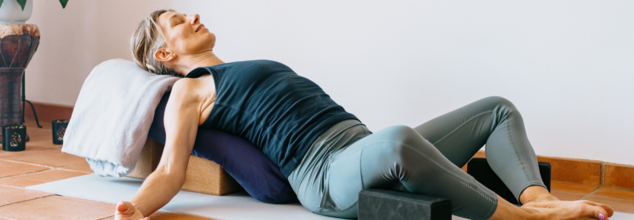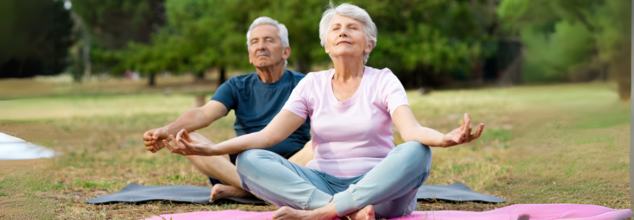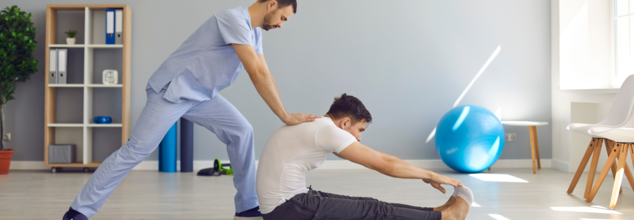- Health Conditions A-Z
- Health & Wellness
- Nutrition
- Fitness
- Health News
- Ayurveda
- Videos
- Medicine A-Z
- Parenting
- Web Stories
Mid-Week Exhaustion Hitting Hard? Restorative Yoga Poses To Get You Through The Week

(Credit-Canva)
While the beginning of every week may be difficult, reaching midway and realizing you still have a few more days to work can be even more exhausting. That is where restorative yoga comes in.
Restorative yoga is all about being gentle, supportive, and therapeutic. At its heart, it's a practice of passive healing, meaning you allow your body to relax deeply rather than actively working your muscles. This style is known for activating your parasympathetic nervous system, often called the "rest and digest" system.
Why Should You Do Restorative Yoga?
By encouraging longer holds in poses (asanas) and deep breathing, it helps trigger your body's natural relaxation response, which can slow breathing, lower blood pressure, and create a sense of calm and well-being.
Restorative yoga uses props like bolsters, blocks, or folded blankets to make poses gentler and more supportive, though you can do them without props too. You'll generally hold these poses for at least 5 minutes, and often much longer if comfortable (some people hold them for 20 minutes or more). The focus is always on comfort and deep relaxation, allowing your body to release tension naturally.
Restorative Yoga Poses To Try
Restorative yoga is a passive, meditative form of yoga that emphasizes deep breathing and releasing physical tension. Unlike active yoga styles, you hold poses for extended periods, typically 5 minutes or more. It often uses props like blankets, blocks, or bolsters to support your body, allowing for deeper relaxation and comfort in each pose. This gentle practice is generally considered safe for most people. If you have any health concerns, it's always wise to talk to your doctor or physical therapist before starting restorative yoga.
Child's Pose
This pose helps calm stress and tiredness. It gently stretches your spine, hips, and shoulders. To do it, kneel with your buttocks on your heels, then lean forward, resting your torso between your thighs. Extend your arms forward or alongside your body. You can use cushions for support. Stay for up to 5 minutes, breathing deeply.
Supported Reclined Bound Angle Pose
This pose opens hips and calms your nervous system, deeply relaxing your body and mind. It's great for stress, anxiety, and menstrual comfort, offering a gentle inner thigh stretch. Lie back on a bolster with supported knees, breathing deeply for 10-20 minutes of serene release.
Supported Supine Spinal Twist
This gentle twist releases spine and lower back tension, while calming your nervous system. Props let your body fully relax into the twist, soothing abdominal organs and aiding digestion. It's perfect for unwinding after a long day or before sleep. Hold for 5-10 minutes per side.
Supported Wide-Legged Forward Fold
This pose offers a gentle stretch for inner thighs and hamstrings, while deeply calming your mind. Props allow you to relax into the fold without strain, making it great for reducing stress and anxiety. It encourages quiet reflection and unwinding. Hold for 5-15 minutes, breathing smoothly.
Corpse Pose (Savasana)
This is a go-to pose for deep relaxation and easing stress. To do it, lie on your back with a folded blanket under your head and a bolster or blankets under your knees for support. Let your arms rest naturally at your sides, palms up. Stay for 10 minutes or more, breathing deeply and letting all your muscles relax.
Legs-Up-The-Wall Pose
This pose helps relieve tired legs and feet, gently stretches your hamstrings and neck, and can ease mild backache. Sit sideways against a wall, then swing your legs up the wall. Use a blanket for your head and optionally for lower back support. Rest your arms comfortably, breathe deeply, and relax your body for 10 minutes.
Can Exercising Too Much Affect Fertility And Delay Pregnancy?

Credits: Canva
Exercise is universally recognized as a cornerstone of physical and mental well-being. It strengthens the heart, enhances brain function, supports metabolism, and plays a key role in managing stress. But when it comes to fertility, especially for couples trying to conceive, there’s a delicate balance. While moderate exercise can significantly improve the chances of conception, overtraining or pushing the body into an energy deficit may do just the opposite.
According to recent data, moderate physical activity improves fertility by up to 27% in women and can lead to a 44% increase in total sperm count in men. But, as with most things in health, more isn’t always better.
How Moderate Exercise Enhances Fertility?
For those trying to conceive, physical activity is a potent ally. “Exercise is not just about being fit—it's a powerful solution for reproductive health,” says Dr. Nishi Singh, IVF specialist. “Moderate, regular exercise can truly be a life-changer for those struggling to conceive.” Here’s how moderate movement helps reproductive function:
Hormonal Harmony: Exercise plays a critical role in balancing hormones like estrogen, progesterone, and testosterone—all essential for fertility.
Healthy Weight Maintenance: Maintaining a healthy BMI helps reduce obesity-related fertility complications, such as insulin resistance and anovulation.
Improved Ovulation & Egg Quality: Enhanced blood flow to the ovaries improves the quality of the eggs and increases the chances of implantation.
Boosted Sperm Health: In men, strength training and regular cardio are associated with better sperm concentration and motility.
Reduced Stress: Physical activity releases endorphins, lowering stress—a known inhibitor of ovulation and libido.
What Counts as “Moderate” Exercise?
Moderate activity includes any movement that raises your heart rate, increases your breathing, and warms up your body—without pushing you to exhaustion. Think:
- Brisk walking
- Cycling on flat terrain
- Light jogging
- Swimming
- Low-impact aerobics
“You should still be able to talk but not sing,” explains Dr. Singh, outlining how to self-assess moderate intensity. These activities encourage cardiovascular health, balance hormones, and reduce cortisol (the stress hormone), all of which can improve fertility outcomes.
When Exercise Becomes Too Much of a Good Thing?
While movement is often seen as medicine, excessive exercise—particularly when not paired with proper nutrition—can lead to an energy deficit. This occurs when the body doesn’t receive enough fuel to sustain its essential functions, including reproduction. In women, this imbalance can result in irregular or missed menstrual cycles, disrupted ovulation, lower estrogen levels, and diminished egg quality. For men, overtraining may suppress testosterone production and lead to a reduced sperm count, ultimately affecting fertility potential.
“The reproductive system is highly sensitive to energy deficit,” says Dr. Singh. “When the body doesn’t have enough fuel, it prioritizes survival systems like the heart and brain over reproduction.”
How Underweight or Overweight Status Affects Fertility?
Body weight is another critical aspect linked to fertility. A BMI below 18.5 (underweight) or within the obese range can trigger ovulatory disorders, hormonal imbalance, and menstrual irregularities.
Even when ovulation seems regular, issues like insulin resistance, thyroid dysfunction, and polycystic ovarian syndrome (PCOS)—often tied to weight extremes—can hinder conception. Regular moderate exercise supports optimal weight, insulin sensitivity, and thyroid health.
List of Fertility-Friendly Workouts
Dr. Singh emphasizes the importance of a balanced fitness plan that supports the body’s reproductive goals:
Cardio: Walking, swimming, or light jogging to build endurance and improve circulation.
Strength Training: Helps prepare the body for pregnancy by building muscular support for the core and lower body.
Mind-Body Workouts: Yoga and Pilates reduce stress, improve flexibility, and support hormonal balance, creating an ideal environment for conception.
“If you’re unsure how much exercise is right for you, consult a fertility specialist or trainer familiar with pre-conception fitness,” she advises.
Every body is different—and so is every fertility journey. What works for one couple may not be ideal for another. The key lies in listening to your body and monitoring symptoms.
Here are some red flags that your exercise regimen may be negatively impacting fertility:
- Missed or irregular periods
- Low libido
- Constant fatigue or overtraining injuries
- Plateauing or regressing physical performance
In these cases, cutting back on intensity, increasing caloric intake, or taking rest days may help restore hormonal balance.
Exercise can be an incredible fertility booster—when done in moderation. It helps regulate hormones, improves reproductive organ function, boosts egg and sperm health, and reduces stress. However, overdoing it can tip the scales in the wrong direction, potentially delaying conception.
As Dr. Singh puts it, “Effective exercise is not about pushing harder—it’s about working smarter. A moderate, sustainable fitness plan not only supports overall wellness but creates the best possible environment for a healthy pregnancy.”
If you’re actively trying to conceive, consider syncing your fitness goals with your fertility goals. Whether that means dialing it back or adding gentle movement to your day, the right approach can make all the difference.
Keep Your Heart Healthy With These Poses - Yoga For Cardiovascular Health

We often think of exercise as just two things: getting our heart pumping with activities like running or building muscles by lifting weights. But there are two other really important parts of fitness: flexibility and balance. These are super important, especially as we get older. Yoga is amazing because it can work on all four of these at a time. Plus, new studies suggest yoga has good effects on many things that keep your heart healthy.
Many believe yoga is only about physical poses, but it offers much more. Yoga is a powerful tool for a healthy heart, connecting your body, mind, and breath. It also aids in weight management and improves flexibility. Combining yoga with other exercises is crucial for overall fitness and a strong heart.
How Yoga Helps Your Heart
A keyway yoga benefits your heart is by reducing stress. Managing stress is super important for your overall well-being, and yoga is excellent at this. Regular practice also boosts your flexibility, strength, and stamina. This combination of stress relief and physical improvement makes yoga a powerful ally for heart health.
Tadasana (Mountain Pose)
This basic pose is excellent for heart health and strengthens your lower back. Stand tall, join your feet, interlock hands, and stretch arms upwards while inhaling. Look up gently, hold for 5-10 seconds, then repeat. It's a simple start for better posture and stability.
Utkatasana (Chair Pose)
The Chair Pose boosts your breathing, which directly helps your heart. It's a great "heart-opening" pose. Start standing, bend knees as if sitting, and raise arms. Keep shoulders relaxed. Hold for 5-10 breaths, then slowly return. This builds leg strength and improves circulation.
Vrikshasana (Tree Pose)
As easy as Mountain Pose, Tree Pose strengthens shoulders and improves posture. Stand tall, lift one leg to your inner thigh, and bring hands together above your head. Keep your back straight and hold for a few breaths. This pose enhances balance and focus.
Uttanasana (Standing Forward Bend)
Uttanasana is a calming, relaxing pose that helps soothe your mind, though it needs some flexibility. Begin standing tall, then exhale and bend forward from your waist. Place hands on the floor near your feet. Hold briefly and release. This stretch can relieve stress and gently decompress your spine.
Padangusthasana (Big Toe Pose)
This pose is great for reducing stress and anxiety, working your thighs and calves. It also helps manage high blood pressure. Stand, put hands on hips, exhale, and bend to grab your big toes. Pull your belly in. Hold briefly and release. This deep stretch can calm your nervous system.
Adho Mukho Svanasana (Downward-Facing Dog Pose)
Downward Dog calms your mind and improves balance. It strengthens your shoulders and knees. Start on hands and knees, lift hips back, forming an inverted V-shape. Press through palms, keep legs active. Hold for 5-8 breaths. This pose stretches the whole body and sends blood flow to the brain.
Paschimottanasana (Seated Forward Bend)
This pose can boost your immune system and is excellent for heart health, though it requires flexibility. Sit with legs together, lean forward from your waist, trying to touch your stomach to thighs. Hold for 8-10 breaths. This deep stretch calms the brain and relieves stress.
Setu Bandhasana (Bridge Pose)
The Bridge Pose improves balance, strengthens your body, and helps relieve stress. Lie on your back, feet apart. Press down to lift hips off the mat. Place arms by your sides. Push hips up, hold for 3-4 breaths, then release. This pose stretches the chest and neck, while strengthening the back and glutes.
Experiencing Sharp Back Pain? Tackle Upper Back Pain With These Yoga Poses

(Credit-Canva)
Good posture is super important for a healthy spine and strong upper back muscles. But simply sitting up straight isn't always enough to prevent or fix upper back pain. That's where yoga poses can really help!
Everyday habits, things like texting, typing on a computer, or carrying a heavy bag can worsen your pain. Medical experts also point to overusing your back muscles or pressure on your spinal nerves from a herniated disc as other common causes.
Yoga Poses For Upper Back Pain
While yoga can definitely help ease upper back pain, it's important to practice safely to avoid further injury. Claudia Jasper advises that when you do these stretches, always be mindful not to let your shoulders roll forward. Instead, actively roll your shoulders back throughout your practice. This movement helps your shoulder blades slide down your back, opening your chest and keeping your spine long and healthy.
If you have ongoing (chronic) upper back pain, always talk to your doctor before starting any new exercise routine.
Cat Pose (Marjaryasana) and Cow Pose (Bitilasana)
This gentle flow is a fantastic way to warm up and energize your upper back. Make sure to move slowly and smoothly between the two poses. You can do this classic pair on your hands and knees (Tabletop position) or even while sitting comfortably in Easy Pose.
Thread the Needle Pose (Urdhva Mukha Pasasana)
This calming pose is excellent for opening your upper back and releasing tension in your shoulders. It encourages your shoulder blades to move away from your spine, creating more length and space. Start from a Tabletop position to enter this pose.
Eagle Arms (Garudasana)
Eagle Arms is a great stretch for your upper back and shoulders. You can do this arm position on its own, while sitting in a chair, or as part of the full Eagle Pose. You can also combine it with Hero Pose for added benefits.
Extended Puppy Pose (Uttana Shishosana)
Can't decide between the relaxation of Child's Pose and the stretch of Downward-Facing Dog? Extended Puppy Pose combines elements of both! It helps to lengthen and stretch your entire spine. Claudia Jasper loves this pose for opening the chest and shoulders, which is key for relieving upper back pain. You can even place a block under your forehead for extra comfort.
Camel Pose (Ustrasana)
Camel Pose is a favorite of Jasper's for upper back relief. This gentle backbend opens your heart, chest, and shoulders, allowing you to breathe more deeply into your upper body. You can adjust how deep the stretch is by keeping your hands on your lower back or placing them on blocks.
Supported Reclining Bound Angle Pose (Supta Baddha Konasana)
Give your upper back some much-needed relief in this supported, relaxing pose. Claudia Jasper particularly likes using a bolster (a long pillow) for an extra chest stretch. To set up, place the bolster along your spine at the top of your mat. Sit down at the top of your mat, bring the soles of your feet together with your knees spread open, and gently lie back onto the bolster so it's aligned with your spine.
© 2024 Bennett, Coleman & Company Limited

